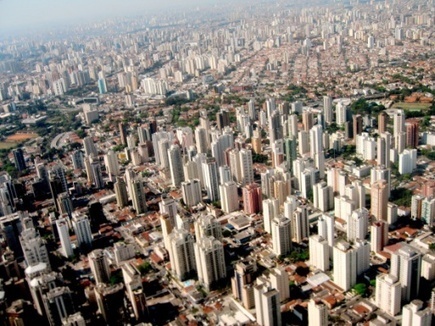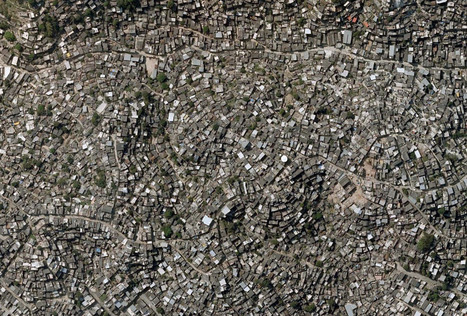Urbanization has led to what are known as mega-cities, cities with a population of over 10 million people. These mega-cities have become so large that they often lead to terrible pollution, traffic, and extreme poverty.
Get Started for FREE
Sign up with Facebook Sign up with X
I don't have a Facebook or a X account
 Your new post is loading... Your new post is loading...
 Your new post is loading... Your new post is loading...

Joseph Thacker 's curator insight,
April 15, 2014 5:57 PM
Wow, I cannot imagine living in these conditions. It looks smaller than a prison cell; only people pay to live there. These extreme living conditions are a result of over population in an area. It seems the city of Hong Kong is running out of places to build and house the abundance of people living there. It appears the average person in Hong Kong lives in these conditions due to the high price tags on larger apartments. This is a sad reality. 
Jess Deady's curator insight,
May 1, 2014 11:06 AM
Living in such close quarters must be incredibly hard to do for those people who are new to Hong Kong and know something different. For Chinese residents, this is normal. Living in such small areas is a part of the Chinese daily life and culture. China is so population dense that this is the result of living there, tiny living spaces.
James Hobson's curator insight,
October 6, 2014 3:47 PM
(in-class 4: Hong Kong) What I take away from this is the theme of supply and demand. Though these condiions seem stereotypically negative, it seems like those who live in the photographed homes are relatvely well off (food, TV, clothing, etc.). This supports the view that living in these tight conditions is less of a choice and more of something that has to be put up with. Now that Hong Kong has been developed 'across', it'd be a good guess to say that recently investments have been made to build 'up' with highrises and skyscrapers (unless like Dubai they sat to mak either own islands, whic geographically would be less likely here). The questionof sustainability is also an issue, i.e. at what point will it be impossible to cram in any more inhabitants? I wonder if a future migration / spreading-out into other areas has started to occur yet or will soon, like the suburbanization which occured in the U.S. after the advent of the automobile. If so, would it be mainland China, despite the political tensions?

Kaitlin Young's curator insight,
September 17, 2014 12:10 PM
In a time where more people are moving away from their rural roots to try and make it big in the city, I think it's becoming more and more important that we focus on how to utilize our urban surroundings in a beneficial way. These photos are proof that it is possible, and I believe that cities in the United States should be more open to urban farming. It could be a way to not only take pressure off of families in cities trying to feed their children, but will also educate all sorts of people on where food comes from, and the importance of the environment. 
Maria la del Varrio's curator insight,
December 13, 2014 3:16 PM
Urban agriculture is a reality in third world countries. In Dominican Republic almost everyone in the country side have its own land to plant necessary food and fruits. The most popular is plantain and fruit is orange. In urban areas is rare to see this, so is surprising to see how central Asians are doing it.
BrianCaldwell7's curator insight,
March 16, 2016 3:58 PM
I love Yann Arthus-Bertrand's photography; so many of them are geography lessons in and of themselves as he captures compelling images of the cultural landscape. This particular gallery shows 32 stunning images including this one above showing urban agriculture in Geneva, Switzerland.
Tags: agriculture, food, landscape, images, urban, unit 5 agriculture, unit 7 cities.

Sierra_Mcswagger's curator insight,
September 10, 2014 10:02 AM
This video is primarily talking on the widely known topic of migration. 3 percent of the worlds population is living away from there place of birth. The push of migration from places include poverty, war, and environmental disasters. The migration pull in some places are because of economic opportunity, and political freedom. Migration is increasing, and is thought of as a bad thing.(s.s.) 
Aurora Rider's curator insight,
October 7, 2014 8:59 PM
This video is great for going over the many different aspects that go along with migration. It talks about what migration is and the reasons why people migrate known as push and pull factors. It talks about the different types of migration such as asylum seakers and illegal immigration. It mentions the disadvantages and advantages of migration.
Katelyn Sesny's curator insight,
October 31, 2014 12:27 PM
A great YouTube video- discussing the controversy of international migration among other things that fall into place of the disapproval of international migration. -UNIT 2

Ana Cristina Gil's curator insight,
November 6, 2013 8:36 PM
I don’t find nothing right about tourist visiting the slum, I feel that the tourist are violating there privacy. They are human being not some historical landmark. If the tourist are not helping this people why are they going? If you are going to visit this places do it because you want to help them, not because you think is interesting their way of living.
Cam E's curator insight,
April 1, 2014 11:57 AM
Moral questions are always fun. Personally I don't think going to see slums is all that exploitative in itself, but I would make a distinction between guided tours that cost money, and self-directed tours though. In a guided tour you are paying money to walk through a community and view what life is like for those people, but in a self-directed tour you are just another person walking down the streets and viewing whatever you stumble upon. There are plenty of tours within neighborhoods of different economic value the world over, but these tours are scrutinized because the people touring are as wealthy, or less wealthy, than the people living there. I don't think that a poor community changes this dynamic in an immoral way, as the perceptions of which group is superior come from the own minds of those who feel uncomfortable with it.

Elizabeth Bitgood's curator insight,
April 10, 2014 9:41 AM
This article rises in interesting question. Are tours of slums exploitive or beneficial to the slum dwellers? On the one hand the tours could feel like exploitation and the tourist is viewing attractions at a “zoo”, on the other hand it brings people far removed from slum life in contact with it and can change people’s point of view on the slums. It can be beneficial if the tour guides donate money to the slums or jobs are sought by slum dwellers to become tour guides. The question is should slums be hidden away from view or opened up to tourists so that they can see the hardships first hand. I think that this is an issue that is not clearly black or white; there are many shades of gray involved in this issue. |

Roman M's curator insight,
September 10, 2014 9:17 AM
At first, the world's population did not grow a lot. Now we are growing about 1 billion in 12 years, that is scary compared to the 200 years we grew about 1 billion. These are some pictures of some highly dense populations. It is even scarier that in 2100 the population is suspected to be 15 billion. 
jada_chace's curator insight,
September 10, 2014 9:25 AM
Over the years our world population has grown enormously. Almost 200 years ago there was only 1 billion people in the world, and as time went on the population started to increase dramatically. By 2100, geographers say the population will grow to be 150 million people in the world. The population continues to grow throughout time, we therefore should be cautious on how we are to our environment.
Gene Gagne's curator insight,
November 22, 2015 12:49 PM
I saw the pictures. It is amazing how peoples back yards are all different. From water to dirt to garbage to no back yards at all. I was commenting on the fact with the population growth there is only one way to build and that is up. Then i saw the pictures of the High risers and how tall they were and so close together. It is a no wonder people live in a stressful environment. There is nothing like living in a wide open land lot with grass in Wyoming or Montana but that sure will change in the next 50 years.

Steven Flis's curator insight,
December 17, 2013 2:12 PM
Its been known that Americans have lavish lifestyles compared to outher populous countries. In this article they show a represntation if the entire world lived like (had as much space) americans and it was astoudning. It would take 4 earths to fit the world if everyone had this lavish lifestyle. So we obviously need to change our ways. Cities ae very helpful to sharing this earth. They serve as a main hub so youll only have to ship to a few places. This with the shortening of distances would save tons of gas and othe rescources. But as the article states everyone living in a Main city wouldnt be possible because people need to produce outside the city. So in my opinion for this city world to work it would need to be a few megacities preferably one on each continent and for them to the city be surronded by production methods.
Peter Hillman's curator insight,
July 22, 2014 11:42 PM
An interactive site for comparisons of city sizes |


















mega cities